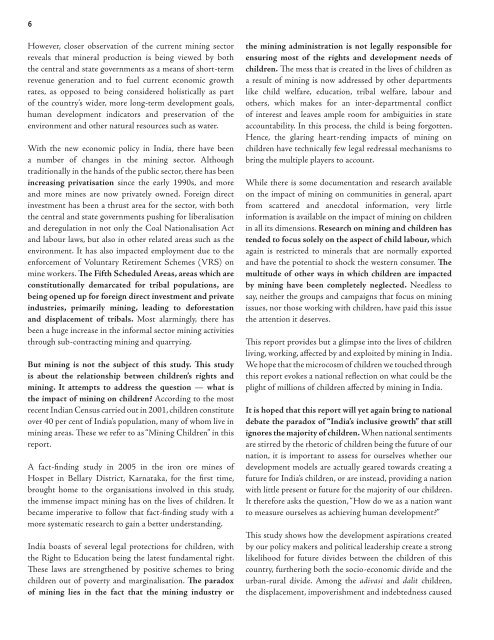Children - Terre des Hommes
Children - Terre des Hommes
Children - Terre des Hommes
You also want an ePaper? Increase the reach of your titles
YUMPU automatically turns print PDFs into web optimized ePapers that Google loves.
6<br />
However, closer observation of the current mining sector<br />
reveals that mineral production is being viewed by both<br />
the central and state governments as a means of short-term<br />
revenue generation and to fuel current economic growth<br />
rates, as opposed to being considered holistically as part<br />
of the country’s wider, more long-term development goals,<br />
human development indicators and preservation of the<br />
environment and other natural resources such as water.<br />
With the new economic policy in India, there have been<br />
a number of changes in the mining sector. Although<br />
traditionally in the hands of the public sector, there has been<br />
increasing privatisation <br />
and more mines are now privately owned. Foreign direct<br />
investment has been a thrust area for the sector, with both<br />
the central and state governments pushing for liberalisation<br />
and deregulation in not only the Coal Nationalisation Act<br />
and labour laws, but also in other related areas such as the<br />
environment. It has also impacted employment due to the<br />
enforcement of Voluntary Retirement Schemes (VRS) on<br />
mine workers. The Fifth Scheduled Areas, areas which are<br />
constitutionally demarcated for tribal populations, are<br />
being opened up for foreign direct investment and private<br />
industries, primarily mining, leading to deforestation<br />
and displacement of tribals. Most alarmingly, there has<br />
been a huge increase in the informal sector mining activities<br />
through sub-contracting mining and quarrying.<br />
But mining is not the subject of this study. This study<br />
is about the relationship between children’s rights and<br />
mining. It attempts to address the question — what is<br />
the impact of mining on children? According to the most<br />
recent Indian Census carried out in 2001, children constitute<br />
<br />
mining areas. These we refer to as “Mining <strong>Children</strong>” in this<br />
report.<br />
A fact-finding study in 2005 in the iron ore mines of<br />
Hospet in Bellary District, Karnataka, for the first time,<br />
brought home to the organisations involved in this study,<br />
the immense impact mining has on the lives of children. It<br />
became imperative to follow that fact-finding study with a<br />
more systematic research to gain a better understanding.<br />
India boasts of several legal protections for children, with<br />
the Right to Education being the latest fundamental right.<br />
These laws are strengthened by positive schemes to bring<br />
children out of poverty and marginalisation. The paradox<br />
of mining lies in the fact that the mining industry or<br />
the mining administration is not legally responsible for<br />
ensuring most of the rights and development needs of<br />
children. The mess that is created in the lives of children as<br />
a result of mining is now addressed by other departments<br />
like child welfare, education, tribal welfare, labour and<br />
others, which makes for an inter-departmental conflict<br />
of interest and leaves ample room for ambiguities in state<br />
accountability. In this process, the child is being forgotten.<br />
Hence, the glaring heart-rending impacts of mining on<br />
children have technically few legal redressal mechanisms to<br />
bring the multiple players to account.<br />
While there is some documentation and research available<br />
on the impact of mining on communities in general, apart<br />
from scattered and anecdotal information, very little<br />
information is available on the impact of mining on children<br />
in all its dimensions. Research on mining and children has<br />
tended to focus solely on the aspect of child labour, which<br />
again is restricted to minerals that are normally exported<br />
and have the potential to shock the western consumer. The<br />
multitude of other ways in which children are impacted<br />
by mining have been completely neglected. Needless to<br />
say, neither the groups and campaigns that focus on mining<br />
issues, nor those working with children, have paid this issue<br />
the attention it <strong>des</strong>erves.<br />
This report provi<strong>des</strong> but a glimpse into the lives of children<br />
living, working, affected by and exploited by mining in India.<br />
We hope that the microcosm of children we touched through<br />
this report evokes a national reflection on what could be the<br />
plight of millions of children affected by mining in India.<br />
It is hoped that this report will yet again bring to national<br />
debate the paradox of “India’s inclusive growth” that still<br />
ignores the majority of children. When national sentiments<br />
are stirred by the rhetoric of children being the future of our<br />
nation, it is important to assess for ourselves whether our<br />
development models are actually geared towards creating a<br />
future for India’s children, or are instead, providing a nation<br />
with little present or future for the majority of our children.<br />
It therefore asks the question, “How do we as a nation want<br />
to measure ourselves as achieving human development?”<br />
This study shows how the development aspirations created<br />
by our policy makers and political leadership create a strong<br />
likelihood for future divi<strong>des</strong> between the children of this<br />
country, furthering both the socio-economic divide and the<br />
urban-rural divide. Among the adivasi and dalit children,<br />
the displacement, impoverishment and indebtedness caused






